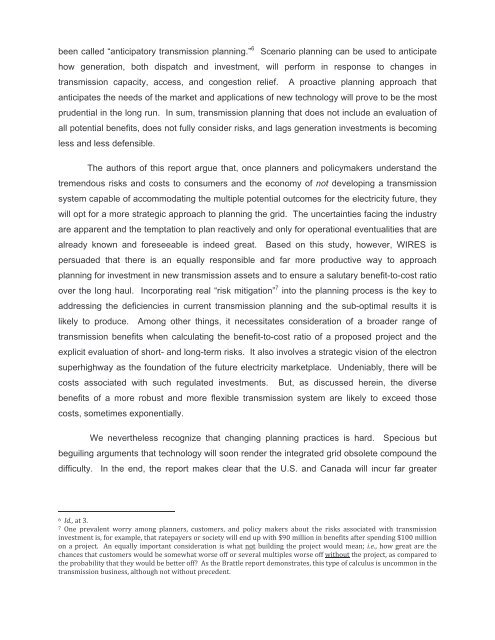THE BRATTLE GROUP
pvrbYG
pvrbYG
You also want an ePaper? Increase the reach of your titles
YUMPU automatically turns print PDFs into web optimized ePapers that Google loves.
een called “anticipatory transmission planning.” 6 Scenario planning can be used to anticipate<br />
how generation, both dispatch and investment, will perform in response to changes in<br />
transmission capacity, access, and congestion relief. A proactive planning approach that<br />
anticipates the needs of the market and applications of new technology will prove to be the most<br />
prudential in the long run. In sum, transmission planning that does not include an evaluation of<br />
all potential benefits, does not fully consider risks, and lags generation investments is becoming<br />
less and less defensible.<br />
The authors of this report argue that, once planners and policymakers understand the<br />
tremendous risks and costs to consumers and the economy of not developing a transmission<br />
system capable of accommodating the multiple potential outcomes for the electricity future, they<br />
will opt for a more strategic approach to planning the grid. The uncertainties facing the industry<br />
are apparent and the temptation to plan reactively and only for operational eventualities that are<br />
already known and foreseeable is indeed great. Based on this study, however, WIRES is<br />
persuaded that there is an equally responsible and far more productive way to approach<br />
planning for investment in new transmission assets and to ensure a salutary benefit-to-cost ratio<br />
over the long haul. Incorporating real “risk mitigation” 7 into the planning process is the key to<br />
addressing the deficiencies in current transmission planning and the sub-optimal results it is<br />
likely to produce. Among other things, it necessitates consideration of a broader range of<br />
transmission benefits when calculating the benefit-to-cost ratio of a proposed project and the<br />
explicit evaluation of short- and long-term risks. It also involves a strategic vision of the electron<br />
superhighway as the foundation of the future electricity marketplace. Undeniably, there will be<br />
costs associated with such regulated investments. But, as discussed herein, the diverse<br />
benefits of a more robust and more flexible transmission system are likely to exceed those<br />
costs, sometimes exponentially.<br />
We nevertheless recognize that changing planning practices is hard. Specious but<br />
beguiling arguments that technology will soon render the integrated grid obsolete compound the<br />
difficulty. In the end, the report makes clear that the U.S. and Canada will incur far greater<br />
6 Id., at 3.<br />
7 One prevalent worry among planners, customers, and policy makers about the risks associated with transmission<br />
investment is, for example, that ratepayers or society will end up with $90 million in benefits after spending $100 million<br />
on a project. An equally important consideration is what not building the project would mean; i.e., how great are the<br />
chances that customers would be somewhat worse off or several multiples worse off without the project, as compared to<br />
the probability that they would be better off? As the Brattle report demonstrates, this type of calculus is uncommon in the<br />
transmission business, although not without precedent.


